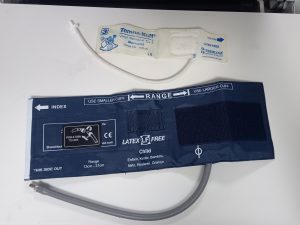2-Piece Reusable Blood Pressure Cuff with Sphygmomanometers for checking blood pressure
Description
Blood pressure inflation system or inflation system parts for use with non-invasive mechanical or electro-mechanical sphygmomanometers.
The inflation systems are manufactured in conformance “Non-Invasive Sphygmomanometers
Check here for Non-Invasive Sphygmomanometers
Supplementary requirements for mechanical sphygmomanometers are subject to stringent quality control.
Checking Blood Pressure
Blood pressure measurements should be taken by trained personnel following established procedures.
Select the appropriate size cuff based on the patient’s arm circumference. The bladder width should be 40% of the arm circumference with the bladder encircling at least 80 percent of the arm; 100 percent for a child’s arm. Use of the wrong size cuff can affect the accuracy of the measurement.
Normal Blood Pressure 120 systolic / 80 diastolic
Position patient properly in a seated position with the midpoint of the upper arm at the level of the heart. Some circumstances may require alternate positioning Record the patient’s position on their chart.
Attach cuff to monitoring device as follows:
For Double Tube Cuffs:
When using electronic NIBP units, attach both tubes to the electronic monitor.
When using manual manometers, attach one tube to a bulb and valve. Attach the other tube to the end of the coiled tubing on the blood pressure manometer or to the hose fitting on the aneroid gauge.
For Single Tube Cuffs:
Attach the tube to the electronic monitor.
Remove clothing from the arm before positioning cuff.
Position the artery symbol on the cuff over the brachial artery and wrap securely on
upper arm.
Close the hook and loop fasteners.
The index line on the cuff should fall within the recommended range.

Select a different size cuff when the index line falls in the “Use Larger Cuff” area or outside the Range.
Take blood pressure in the normal manner. For electronic blood pressure monitoring, be sure to follow the monitor manufacturer’s instructions
caution
when using Luer lock connectors, be careful not to connect cuffs to intravascular fluid systems.
Read here for Respiration Measurement
Cleaning of cuff
Cuff (sleeve)
Remove other inflation system parts (bladder, bulb, valve) before washing. Close the hook and loop fastener. Do not wash cuff with natural fibers such as cotton or wool, as these fibers will cling to the hook and loop.
Machine wash in warm water, then dry at warm setting.
Cuff may be hand washed with mild detergent and drip-dried.
Cuff can be gas sterilized. Do not expose cuff to steam or dry heat sterilization processes.
Bladder
Remove other inflation system parts (bp cuffs, bulb, valve) before cleaning.
Apply a mild detergent to a slightly damp cloth and wipe clean. To avoid getting water inside the bladder, do not immerse tubes.
For bulbs, valves, and tubing apply a mild detergent to a slightly damp cloth and wipe
clean Nylon Bladder
Cuff
Bulb
Valve
Vinyl Bladder
Latex-free material
Adult size
Pediatric size
Infant size
Neonatal size
Normal BP in
Adult
Paediatric
Infants
Neonates
NIBP basic configuration comprises of the following accessories:
Recommended sizes of bp cuffs
Adult (14 cm x 37 cm) (reusable)
Child (9 cm x 27 cm) (reusable)
Neonate (3 cm x 9 cm) (disposable)